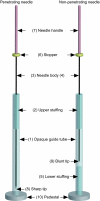A double-blind placebo needle for acupuncture research
- PMID: 17925042
- PMCID: PMC2176062
- DOI: 10.1186/1472-6882-7-31
A double-blind placebo needle for acupuncture research
Abstract
Background: Placebo needles that can mask acupuncture practitioners to the type of needle used have been considered almost impossible to develop until now.
Methods: We designed a double-blind non-penetrating placebo needle, the needle tip of which simply presses against the skin, and a matched penetrating needle. The needles are encased inside an opaque guide tube and the appearance and feel of the pair are designed to be indistinguishable. To validate the masking effect for the practitioner, 10 acupuncturists each applied 23 non-penetrating needles and 17 penetrating needles to the Large Intestine-4 point. After removing each needle, they judged whether the needle was 'penetrating', 'non-penetrating' or 'unidentifiable'. For the validation of patient masking, an acupuncturist randomly applied a non-penetrating/penetrating needle pair to the bilateral Sanjiao-5 points in 60 volunteers. When both applications were completed, we asked them to write down anything that they noticed regarding the needle application and associated sensations.
Results: The mean +/- SD of correct/unidentifiable/incorrect answers given by the 10 acupuncturists were 17.0 +/- 4.1/6.4 +/- 3.6/16.6 +/- 3.0, respectively. Regarding patient masking, none of the subjects commented in the questionnaire that they had received a non-penetrating needle. Of 60 penetrating and 60 non-penetrating needle applications, 48 (80.0%) and 25 (41.7%) applications elicited skin penetration sensation and 48 (80.0%) and 20 (33.3%) applications elicited de qi, respectively.
Conclusion: These needles have the potential to mask both practitioners and patients from the type of needle used in acupuncture research.
Figures

References
-
- Melchart D, Streng A, Hoppe A, Brinkhaus B, Witt C, Wagenpfeil S, Pfaffenrath V, Hammes M, Hummelsberger J, Irnich D, Weidenhammer W, Willich SN, Linde K. Acupuncture in patients with tension-type headache: randomized controlled trial. BMJ. 2005;331:376–382. doi: 10.1136/bmj.38512.405440.8F. - DOI - PMC - PubMed
-
- Berman BM, Lao L, Langenberg P, Lee WL, Gilpin AM. Effectiveness of acupuncture as adjunctive therapy in osteoarthritis of the knee: a randomized, controlled trial. Ann Intern Med. 2004;141:901–910. - PubMed
-
- Assefi NP, Sherman KJ, Jacobsen C, Goldberg J, Smith WR. A randomized clinical trial of acupuncture compared with sham acupuncture in fibromyalgia. Ann Intern Med. 2005;143:10–19. - PubMed
-
- Shapiro AK, Shapiro E. The powerful placebo: From ancient priest to modern physician. London: The Johns Hopkins University Press; 1997. 137-174, 190-216 pp. 190–216.
Publication types
MeSH terms
Substances
LinkOut - more resources
Full Text Sources
Other Literature Sources
Medical

